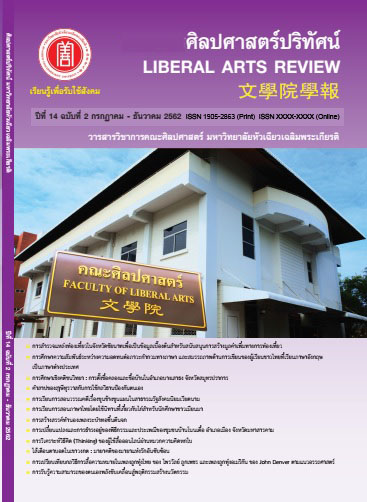Curse of the Durvasa Hermit and Using Self Defense Mechanism
Keywords:
Durvasa Hermit, Curse, Self Defense MechanismAbstract
The study of character behaviors in literature is one of the ways in which readers can see the good results and the results that damage the society. The behavior of the characters leads to learning of the effects of actions and psychoanalytic theories as a way to study behavior, will reflect the emotions, thoughts and personality. In which "Durvasa Hermit" is a person with behavior "the Curse" a study of hermit behavior “Durvasa” will focus on the relationship between identities and the use of self defense mechanisms. Malignant behavior is another context in which the reader of the literature clearly acknowledges the consequences of damaging actions. Results of the hermit behavior study being a person with good mental health requires persistence in desirable behavior, the practicing to have a good quality of life with caution in using self-defense mechanisms. In this article, the author is interested in the perception of the use of self-defense mechanisms that will be the driving force in the context of the problematic behavior, namely the effect of not being able to accept the truth and the problem of creating relationships with others.
References
พระบาทสมเด็จพระมงกุฎเกล้าเจ้าอยู่หัว. (2513). บทละครรำเรื่องศกุนตลา บทละครดึกดำบรรพ์ เรื่องศกุนตลา บทความเรียง และบทละครร้องเรื่องสาวิตรี. (พิมพ์ครั้งที่ 4). กรุงเทพมหานคร: องค์การค้าของคุรุสภา.
มณีปิ่น พรหมสุทธิรักษ์. (2551). ประวัติวรรณคดีสันสกฤต. นครปฐม: โรงพิมพ์มหาวิทยาลัยศิลปากร.
ราชบัณฑิตยสถาน. (2556). พจนานุกรมฉบับราชบัณฑิตยสถาน พ.ศ.2554. กรุงเทพมหานคร: ราชบัณฑิตยสถาน.
ว.จีนประดิษฐ์. (2542). ตำนานพระฤๅษี(ดวงมหาลาภ ฉบับพิเศษ). (กรเทพ เทพโยธิน, ผู้เรียบเรียง). กรุงเทพมหานคร: นิตยสารดวงมหาลาภ.
วาลมีกิ. (2551). รามายณะ. (ราเมศ เมนอน และ วรวดี วงศ์สง่า, ผู้แปล). กรุงเทพมหานคร: เมืองโบราณ.
ศรีเรือน แก้วกังวาล. (2529). อ่านคน อ่านวรรณกรรม. กรุงเทพมหานคร: โอเดียนสโตร์.
ศานติ ภักดีคำ. (2556). พระนารายณ์ ผู้ปราบยุคเข็ญแห่งโลก. กรุงเทพมหานคร: อมรินทร์.
สมเกียรติ โล่เพชรัตน์. (2558). กำเนิดพระฤๅษี ตำนานเเละอภินิหาร. กรุงเทพมหานคร: มูลนิธิส่งเสริมและอนุรักษ์ศิลปะไทย.
Albuquerque, S., Carvalho, E., Lopes, R., Marques, H., Macêdo, D., Pereira, E., & Carvalho, A. (2011). Ego defense mechanisms in COPD: Impact on health-related quality of life and Dyspnea severity. Quality of Life Research, 20(9), 1401–1410.
Cramer, P. (1991). Anger and the use of defense mechanisms in college students. J Pers., 59(1), 39-55.
Devi, P. K. (2016). Bhagavata Purana. Puri Orissa, India: Jagannatha Vallabha Vedic Research Center.
Devi, Parama Karuna. (2016). Bhagavata Purana. Dist. Puri Orissa, India: Jagannatha Vallabha Vedic Research Center.
Durvasa. (n.d.) Retrieved from https://en.wikipedia.org/wiki/Durvasa.
Durvasa: The Rishi of Rage. (2016) Retrieved from http://indiaufo.blogspot.com/2016/01/3-stories-you-should-know-about-durvasa.html.
Freud, A. (1937). The Ego and the mechanisms of defense. London: Hogarth Press and Institute of Psycho-Analysis.
Ganguli, K. M., Trans. (1896). The Mahabharata of Krishna - Dwaipayana Vyasa. Retrieved from https://www.sacred-texts.com/hin/maha/.
Goel, K. (2014). Bhakta Ambarisha Story. Retrieved from https://iskcondesiretree.com/profiles/blogs/bhakta-ambarisha-story.
Guru, S. J. (2018). Durvasa Rishi. Retrieved from http://shrijyotishguru.com/contents.php?article=27.
Hossain, Md. M. (2017). Psychoanalytic Theory used in English Literature: A Descriptive Study. Global Journal of Human-Social Science Research, [S.l.]. Retrieved from https:// socialscienceresearch.org/ index.php/GJHSS/article/view/1970>.
Kaplan, S. (2002). Comprehensive Textbook of Psychiatry. American Journal of Psychiatry, 159(2), 327-327.
Kalidasa. (1999). Shakuntala. (Arthur W. Ryder, Trans.). Cambridge, Ontario: In Parentheses Publications Sanskrit Series.
Larzarus, R. S., & Folkman, S. (1984). Stress, appraisal and coping. New York: Springer Publishing.
Lingiardi, V., Lonati, C., Delucchi, F., Fossati, A., Vanzulli, L., & Maffei, C. (1999). Defense Mechanisms And Personality Desorders. J Nerv Ment Dis. Malone JC, Cohen S, 187, 224-228.
Liu S. R., Vaillant, G.E., & Waldinger, R.J. (2013). Adaptive midlife defense mechanisms and late-life health. Personality and individual differences, 55(2), 85-89.
Müller, F. M. (2006). The Sacred Books of the East: Vol. 25: The Laws of Manu. New Delhi, India : Motilal Banarsidass Publishers.
Pattanaik, D. (2003). Indian Mythology: Tales, Symbols, and Rituals from the Heart of the Subcontinent. Rochester, Vermont: Inner Traditions.
Reeve, J. (2015). Understanding Motivation and Emotion, (6th Ed.). Korea: University of Korea.
Samudra manthan. (n.d.). Retrieved from https://en.wikipedia.org/wiki/Samudra_manthan
Vaillant, G. E. (2000). Adaptive mental mechanisms: Their role in a positive psychology. American Psychologist, 55, 89–98.
Valmiki. (1895). Ramayan of Valmiki. (Ralph T. H. Griffith, Trans.). London: E. J. Lazarus and Co.
Who is the angriest person that has ever lived?. (n.d.) Retrieved from https://www.quora.com/Who-is-the-angriest-person-that-has-ever-lived.
Downloads
Published
How to Cite
Issue
Section
License
บทความที่ได้รับการตีพิมพ์เป็นลิขสิทธิ์ของวารสารศิลปศาสตร์วิชาการและวิจัย
ข้อความที่ปรากฏในบทความแต่ละเรื่องในวารสารวิชาการเล่มนี้เป็นความคิดเห็นส่วนตัวของผู้เขียนแต่ละท่านไม่เกี่ยวข้องกับมหาวิทยาลัยหัวเฉียวเฉลิมพระเกียรติ และคณาจารย์ท่านอื่นๆ ในมหาวิทยาลัยฯ แต่อย่างใด ความรับผิดชอบองค์ประกอบทั้งหมดของบทความแต่ละเรื่องเป็นของผู้เขียนแต่ละท่าน หากมีความผิดพลาดใดๆ ผู้เขียนแต่ละท่านจะรับผิดชอบบทความของตนเองแต่ผู้เดียว




